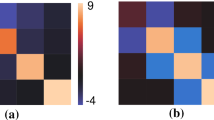Abstract
This paper presents kinematic algorithms for resolved-rate based inverse kinematics of redundant manipulators. Efficient and robust Jacobian and weighted damped least squares algorithms are given which provide a method that allows full utilization of the redundancy to best achieve task requirements. A nominal set of task space variables is suggested and procedures for modifying this specification or their relative priorities due to changing task requirements or events are discussed. Examples are shown using a simulation of the seven degree-of-freeom Robotics Research manipulator. These simulations demonstrate the singularity robustness of the algorithms and the ability to smoothly transition between task parameterizations and relative priorities.
Similar content being viewed by others
References
Hollerbach, J.M., Optimum kinematic design for a seven degree of freedom manipulator, 2nd Int. Symp. Robotics Research, Kyoto, Japan, Aug. 20–23, 1984, pp. 215–222.
Burdick, J.W., Kinematic analysis and design of redundant robot mechanisms, PhD Thesis, Dept. of ME, Stanford, March 1988.
Pieper, D., The kinematics of manipulators under computer control, PhD Thesis, Stanford University, 1968.
Whitney, D.E., Resolved motion rate control of manipulators and human prostheses, IEEE Trans. Man-Machine Syst. MMS-10(2), 47–53 (1969).
Oh, S.Y., Orin, D., and Bach, M., An inverse kinematic solution for kinematically redundant robot manipulators, J. Robotic Systems 1(3), 235–249 (1984).
Seraji, H., Configuration control of redundant manipulators: Theory and implementation, IEEE Trans. Robotics Automat. 5(4), 472–490 (1989).
Liegeois, A., Automatic supervisory control of the configuration and behavior of multibody mechanisms, IEEE Trans. Systems Man Cybernet. SMC-7, 868–871 (1977).
Wampler, C.W., Manipulator inverse kinematic solutions based on vector formulations and damped least-squares methods, IEEE Trans. Systems Man Cybernet. SMC-16(1), 93–101 (1986).
Wampler, C.W. and Leifer, L.J., Applications of damped least-squares methods to resolved-rate and resolved-acceleration control of manipulators, ASME J. Dynamic Systems Meas. Control 110(1), 31–38 (1988).
Nakamura, Y. and Hanafusa, H., Inverse kinematic solutions with singularity robustness for robot manipulator control, ASME J. Dynamic Systems Meas. Control 108(3), 163–171 (1986).
Craig, J.J., Introduction to Robotics, Addison-Wesley, Reading, Mass., 1986.
Fijany, A. and Bejczy, A.K., Efficient Jacobian inversion for the control of simple robot manipulators, 1988 IEEE Int. Conf. Robotics and Automation, Philadelphia, 1988, pp. 999–1007.
Orin, D.E. and Schrader, W.W., Efficient computation of the Jacobian for robot manipulators, Int. J. Robotics Research (1984).
Egeland, O., Task-space tracking with redundant manipulators, IEEE J. Robotics Automat. RA-3, 471–475 (1987).
Kreutz-Delgado, K., Long, M., and Seraji, H., Kinematic analysis of 7 DOF manipulators, JPL Engineering Memorandum (internal document number 347-90-275), January 1990.
Wampler II, C.W., Inverse kinematics of a 7 DOF manipulator, NATO Advanced Research Workshop on Robots with Redundancy: Design, Sensing, and Control, June 27–July 1, 1988, Salo, Salo di Garda, Italy.
Asada, H. and Slotine, J.-J.E., Robot Analysis and Control, Wiley-Interscience, New York, 1986.
Kane, T.R. and Levinson, D.A., Dynamics: Theory and Applications, McGraw-Hill, New York, 1985.
Levenberg, K., A method for the solution of certain non-linear problems in least squares, Quart. Appl. Math. 2(2), 164–168 (1944).
Marquardt, D.W., Generalized inverses, ridge regression, biased linear estimation, and nonlinear estimation, Technometrics 12(3), 591–612 (1970).
Seraji, H. and Colbaugh, R., Improved configuration control for redundant robots, J. Robotic Systems 7(6), 897–928 (1990).
Golub, G.H. and VanLoan, C.F., Matrix Computations, Johns Hopkins University Press, Baltimore, Maryland, 1983.
Oretega, J.M., The ijk forms of factorization methods: I. Vectors computers, Parallel Computing 7, 135–147 (1988).
Fijany, A. and Bejczy, A., Parallel algorithms and architecture for computing of manipulator forward dynamics, Proc. 1991 IEEE Int. Conf. Robotics and Automation.
Lawson, C.L. and Hanson, R.J., Solving Least Squares Problems, Prentice-Hall, Englewood Cliffs, NJ, 1974.
Maciejewski, A.A. and Klein, C.A., Numerical filtering for the operation of robotic manipulators through kinematically singular configurations, J. Robotic Systems 5(6), 527–552 (1988).
Colbaugh, R., Seraji, H., and Glass, K., Obstacle avoidance for redundant manipulators using configuration control, J. Robotic Systems 6(6), 721–744 (1989).
Author information
Authors and Affiliations
Rights and permissions
About this article
Cite this article
Long, M.K. Task-directed inverse kinematics for redundant manipulators. J Intell Robot Syst 6, 241–261 (1992). https://doi.org/10.1007/BF00248018
Received:
Accepted:
Issue Date:
DOI: https://doi.org/10.1007/BF00248018




